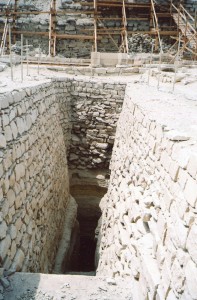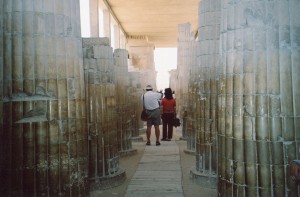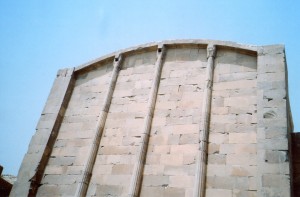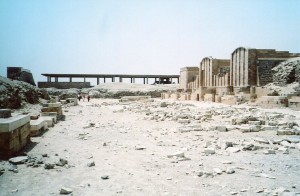In Facts About Djoser’s Step Pyramid at Saqqara, Egypt; Part One, we saw some of the basic reasons why this is one of the world’s greatest buildings.
But this monument holds many mysteries beneath the surface. We’ll explore them in this post.
1. A central shaft over 90 feet deep was dug before the pyramid was built over it.
2. Many long underground passageways were dug from the shaft before the single-leveled tomb was expanded into the pyramid. A central corridor and 2 parallel ones stretch for about 1,200 feet. 3 1/2 miles of shafts, passageways and chambers were quarried out all together.
3. Rows of blue faience tiles were added to some of the walls where Djoser was supposed to have been buried. Specialists have though that they might have simulated the royal palace, the watery associations of the Egyptian afterlife, or both.
4. A 34 foot high rectangular limestone wall was built around the pyramid. It’s 5,400 feet long.
5. The entrance is on the east side, and a line of stone columns leads you in. The stone pillars in this compound were the first ever built in Egypt.
6. The pillars mimic Egypt’s vegetal growth. Older royal halls were made from reeds, so the new stone architecture continued traditions that Egyptians were familiar with. The stone embodied the life that the Nile renewed every year.
7. Enormous courtyards surrounded the pyramid. One was used for the Sed festival, which reenacted the Pharaoh’s coronation. This was repeated at intervals that varied during Egypt’s history. But it was often first conducted 30 years into his reign, and then every 3 years. It probably renewed the aging king’s energy. Preserving the political and cosmic order was a big job!
8. The newly invigorated king then ran laps between two boundary markers. He might have been following a tradition from pre-historic times in which the leader showed that he was still enough of a stud to rule.
The 4th dynasty pharaoh’s who built the great pyramids at Giza didn’t erect huge walled compounds around them.
So the whole layout at Djoser’s step pyramid is special. The underground passageways and the Pharaoh’s burial chamber, the pyramid itself, and the courtyards and chapels that surround the monument added up to the center of Egypt’s world in the 3rd Dynasty. This compound was both a model of order, and a battery of energy that sustained it.
This model reflected many centuries that had been lived around the Nile. You can see the incredibly rich roots of ancient Egyptian life in:
And you can see a fascinating culture that was very different in:






Comments on this entry are closed.